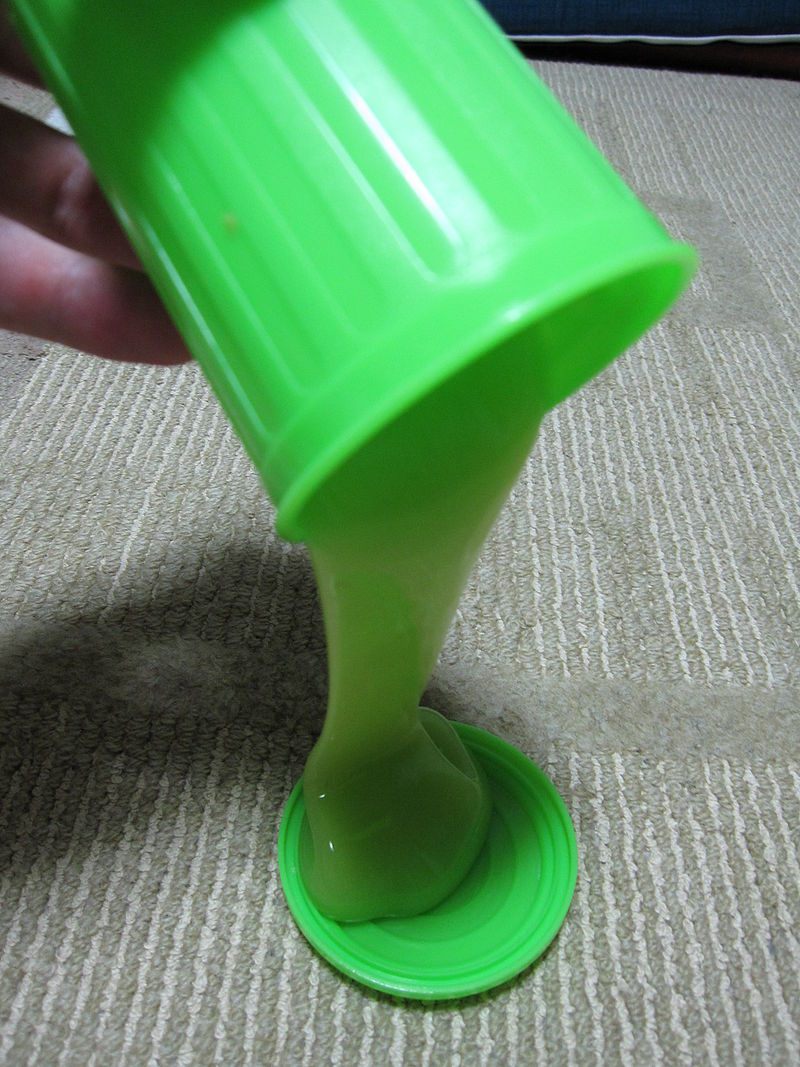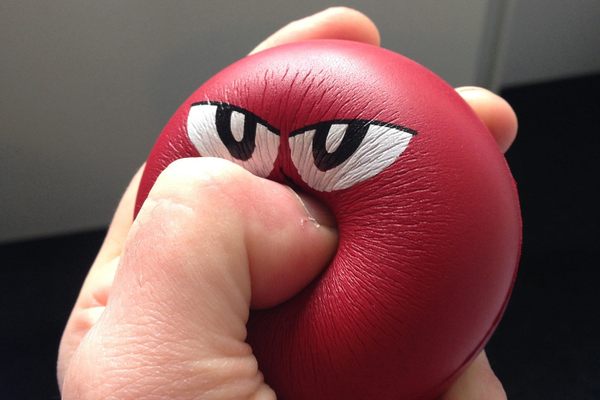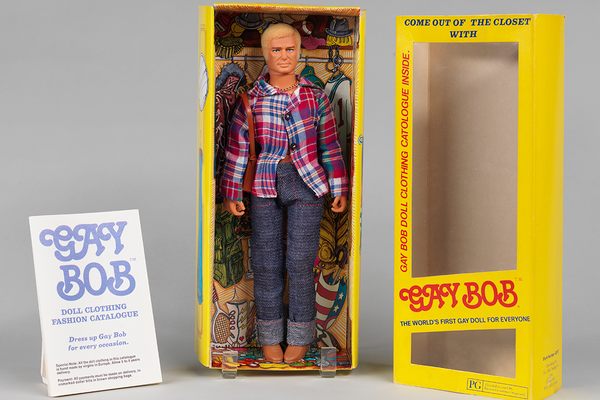The Force was Strong with Toy Slime—Until ‘Star Wars’ Came Along

Where’d the slime go? (Photo: Ciphers/Wikipedia)
Slime. Cold, clammy, smelly, non-staining, but most importantly, fun.
At least, it was for a while. During the ’70s, ’80s, and ’90s, toy slime and toys that featured slime were all the rage in the U.S., much to the chagrin of carpeted households around the nation. In recent years, toy slime has taken a backseat in the toy market, living most vividly in the memories of the adults nostalgic for their former playthings. But slime isn’t exactly gone, it just got lost in a galaxy far, far away.
Toy slime as it is considered today was preceded in 1962 by Flubber. This goop was released in conjunction with the film Son of Flubber, a sequel to The Absent-Minded Professor, in which Fred MacMurray’s Professor Ned Brainerd accidentally invents flying rubber—Flubber. This early toy was made out of synthetic rubber, natural oil, and dye, and was said to have many of the properties seen in the films. However it also had the property of causing folliculitis, an infection of the hair follicles.
As Patricia Hogan, a curator at the National Museum of Play, put it, Flubber “caused kids to get skin rashes from head to toe, fevers, sore throats. As you can imagine, the toy was quickly yanked from the market.” Indeed, Flubber was quickly recalled, but in an interesting side note, the makers of the toy could not find a way to destroy it. After unsuccessfully trying to burn it and sink it, they finally buried the stuff under a warehouse parking lot in Providence, Rhode Island.
Given the Flubber debacle, it’s little wonder that it took more than a decade for anyone to try slime again, but toy company Mattel’s toy goo product, simply named Slime, appeared on toy shelves in 1976. A distinctly different (and much safer) concoction, Mattel’s Slime was described by a Mattel Materials Laboratory scientist as a “reversible cross-linking gel.” It was made of vegetable grade guar gum, a component more often found in food and cosmetic products, and sodium borate, otherwise known as borax. “It was basically food extenders,” says toy expert Christopher Byrne, also known as The Toy Guy. “It tasted nasty, but it wasn’t going to kill you if you ate it.”

Putting the fun back in 1970s toxic waste! (Photo: Kungfuman/Wikipedia)
If all of this talk of chemicals make Slime sound like it was more of a science experiment than a fun toy, note that Mattel got out in front of that issue by packaging the goop in a neon green trash can, positioning it as a gross-out toy, and it began to fly off the shelves. “[It’s] toxic waste you can play with! Yay!” says Byrne. “It’s that ooey, messy type of thing that kids love. What made it so appealing is that it was allowed mess.”
It’s unclear how toy slime as a concept developed—whether it was via directed research and development, or inadvertently as part of another experiment. “Silly Putty was supposed to be wall paper cleaner,” says Byrne. “Especially when chemicals are involved, there are the happy accidents.”
In the early days of Slime’s release, it seemed like it was poised to become its own hit franchise. Mattel began to release other related products like a Slime Monster board game, where players had to avoid having their game piece slimed by a plastic creature, and in 1978 a small catalog of Slime products was released, advertising things like Slime with toy worms hidden inside. But Slime as a franchise was not to be, thanks to the release of a little movie called Star Wars.

Fresh slime, straight from the can. (Photo: Ciphers/Wikipedia)
“[Star Wars] frankly just changes the toy industry completely. Almost over night,” Hogan says. “Every toy manufacturer from that point on looks to associate its product with a pop culture phenomenon.” And so Slime went from being a clammy toy superstar to a side-lined accessory. The other issue was that the simple formula was not patented, making it easy for other companies to replicate.
Soon, Slime stopped being marketed on its own, and started being included with other toys that were part of a larger brand. In He-Man and the Masters of the Universe toys, it was a slime that poured from a giant monster’s skull, turning those it touched evil; in Teenage Mutant Ninja Turtles toys it became the mutagenic ooze that powered the characters’ transformations; for the Real Ghostbusters it was ectoplasm left behind by captured poltergeists. The list of associated slime toys was seemingly endless and probably led to the substance being burned into more adult memories than the original green can ever did. Slime was no longer Mattel’s gross baby, it was the world’s.
This trend continued through the 1980s and into the ’90s, when slime toys once again got another chance at independence. In 1992, Mattel joined up with kid’s TV network Nickelodeon, whose signature thing was—and still is—dumping “slime” on people. Together they produced their own Nickelodeon-branded Slime, in addition to a number of other slime-like “compounds.” Most famously, they had a whole line of Gak, but there were other less-fondly remembered compounds like Smud, Floam, and Zzand. Each different compound, not unlike the original Slime, was made of a simple line-up of non-toxic ingredients that created a fun, and most importantly, icky, toy.

A slime-centric Ghostbusters toy. (Photo: Youtube)
As toy trends evolved from the ’90s into the new millennium, slime toys faded out of popular circulation, save for a resurgence following the updated versions of TMNT, and a few scattered products here and there. Today most slime toys are sold by small companies, and international wholesalers that sell the rights-free toy for pennies.
According to Byrne, there are a couple of different reasons for this. “I do think there is a cultural element of it,” he says. “Somehow mess has become anathema to the modern parent whereas that’s what makes it cool for a kid.” But it’s not that parents just don’t understand. The true issue may be that slime toys just aren’t big money makers. “These things aren’t going to sell at a rate that’s really profitable for a company to do,” Byrne explains. “So it does fall to the smaller companies that aren’t going to invest in getting a license on it.”
While Slime toys may no longer be the hot thing to gross out your friends with, toy goo may not be completely dead either. Byrne points to the current trend of stop-motion animation toys, which kids are using to create their own videos and share them on social media. “You have a very low tech toy, with a very high-tech building of community,” he says. Maybe all Slime needs is a solid Instagram campaign. #slimetime, anyone?








Follow us on Twitter to get the latest on the world's hidden wonders.
Like us on Facebook to get the latest on the world's hidden wonders.
Follow us on Twitter Like us on Facebook